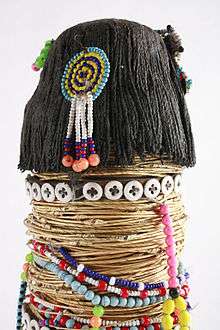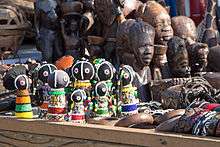African dolls


African dolls across the continent are created for young girls to play with and as a charm to ensure fertility in women. Their shape and costume vary according to region and custom. Frequently dolls are handed down from mother to daughter. Western dolls are popular in Africa and are often dressed with traditional garb.
When the doll concept is considered in the context of African culture, they are usually not children's playthings, but rather objects that are laden with ritual and religious associations within the community. African dolls are used to teach, and entertain. They are supernatural intermediaries and they are manipulated for ritual purposes. Each of these dolls is unique because they are handmade and are traditionally handed down through generations.
Ndebele dolls
Linga Koba dolls are from the Ndebele people in Southern Africa. One of the smallest tribes of the region, the Ndebele are noted for their painted homes of brilliant colors that stand out in the drab countryside. Their clothing is similarly colorful. The bead work on these Ndebele dolls is as detailed as the clothing of the women themselves.
During courtship, a suitor will place a doll outside a young woman's hut, indicating his intention to propose marriage to her. When a young woman is preparing to marry, she is given a doll that she names and cares for. Her first child is then named for the doll.
In addition to strengthening the Ndebele cultural identity, the beaded Ndebele dolls are now an important export item and much needed source of income for the Ndebele woman.
See also
References
- Cameron, Elisabeth. Isn't S/He a Doll? Play and Ritual in African Sculpture. Los Angeles: UCLA Fowler Museum of Cultural History, 1996.
- Dagan, Esther A. African Dolls for Play & Magic. Montreal: Galerie Amrad African Arts,1990.
- Green, Yako. African Girl and Boy Paper Dolls. New York: Dover Publications, Inc. 1997
- Larson, Jack Lenor. Folk Art from the Global Village. Santa Fe, NM: Museum of New Mexico Press, 1995.